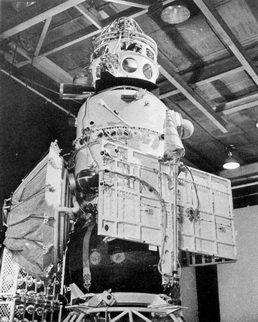If you are not already a subscriber, you are welcome to enter your email address here to sign up to receive the Space History newsletter on a daily basis. Under no circumstances will we release your legitimate email address entered here to outside persons or organizations, and it will only be used for mailing the specific information you have requested.
| Enter your email address here: |
Unsubscribe instructions are included in every newsletter issue in case you decide you no longer wish to receive it.
Note: We record the IP address from which subscriptions are entered to help prevent SPAM abuses.
Race To Space
Someone will win the prize...
... but at what cost?
Visit RaceToSpaceProject.com
to find out more!
1625
Died, Simon Marius, German astronomer
Simon Marius (10 January 1573 (Julian calendar then in effect, 20 January Gregorian) - 5 January 1625 (Gregorian calendar then in effect, 26 December 1624 Julian)) was a German astronomer. In 1614, Marius published his work Mundus Iovialis describing the planet Jupiter and its moons in which he claimed to have discovered the planet's four major moons some days before Galileo. This led to a dispute with Galileo, who accused Marius, not only of being a liar, but also of having copied his own work so that his Mundus Iovialis was nothing but plagiarism. It is considered possible that Marius discovered the moons independently, but at least some days later than Galileo. Regardless of priority, the mythological names by which the satellites are known (Io, Europa, Ganymede and Callisto) are those given them by Marius. Simon Marius also claimed to be the discoverer of the Andromeda Galaxy, which was already known to Arab astronomers of the Middle Ages.
ref: en.wikipedia.org
1859
Born, DeWitt B. Brace, astronomer, inventor (spectrophotometer)
ref: en.wikipedia.org
1865
Born, Julio Garavito Armero, Colombian astronomer (celestial mechanics)
Julio Garavito Armero (5 January 1865 - 11 March 1920) was a Colombian astronomer. He was a child prodigy in science and mathematics, and obtained degrees in mathematics and civil engineering. As an astronomer at the Observatorio Astronomico Nacional (National Astronomical Observatory) in Columbia, his researches included calculating the latitude of Bogota, studies about the comets which passed the Earth between 1901 and 1910 (such as Comet Halley), and the 1916 solar eclipse (seen in the majority of Colombia). The most widely important aspects of his studies were about celestial mechanics, Lunar fluctuations and their influence in weather, floods, polar ice, and Earth's orbital acceleration.
ref: en.wikipedia.org
1892
The first successful auroral photograph was made, a black and white image captured by German physicist Martin Brendel.
ref: scied.ucar.edu
1895
Born, Jeannette Ridlon Piccard, first US woman free balloon pilot, held the women's altitude record for nearly three decades
ref: en.wikipedia.org
1905
Jupiter's eighth largest satellite Elara (named in 1975, previously known as Jupiter VII) was discovered by Charles Dillon Perrine at Lick Observatory.
ref: en.wikipedia.org
1924
K. Reinmuth discovered asteroid #1011 Laodamia.
1930
K Reinmuth discovered asteroid #1162 Larissa.
1960
Died, Pavel P. Parenago, Soviet astronomer
ref: en.wikipedia.org
1963
USSR's Sputnik 25 re-entered the atmosphere after its escape stage failed to send it to the Moon for a soft landing.
Sputnik 25, launched 4 January 1963, was an attempted Lunar soft landing, with the purpose of returning data on the mechanical characteristics of the Lunar surface, the hazards presented by the topology such as craters, rocks, and other obstructions, and radiation, in preparation for future manned landings. The 1500 kg spacecraft consisted of a cylindrical section containing maneuvering and landing rockets and fuel, orientation devices and radio transmitters and a spherical top containing a 100 kg "lander," which was planned to be ejected onto the surface after the main body touched down, carrying a camera and devices to measure radiation.
The spacecraft was injected into Earth orbit successfully by the SL-6/A-2-e launcher but failed to escape orbit for its trip to the Moon. Its orbit decayed on 5 January 1963 after one day.
ref: nssdc.gsfc.nasa.gov
1969 06:28:00 GMT
USSR launched Venera 5 toward Venus.

USSR Venera 5 Venus probe
Source: NSSDCA Master Catalog
Venera 5 was launched 5 January 1969 towards Venus to obtain atmospheric data. The spacecraft was very similar to Venera 4 although it was of a stronger design. When the atmosphere of Venus was approached, a capsule weighing 405 kg and containing scientific instruments was jettisoned from the main spacecraft. During satellite descent towards the surface of Venus, a parachute opened to slow the entry rate. For 53 minutes on 16 May 1969, while the capsule was suspended from the parachute, data from the Venusian atmosphere were returned. The spacecraft also carried a medallion bearing the coat of arms of the USSR and a bas-relief of V.I. Lenin to the night side of Venus.
ref: nssdc.gsfc.nasa.gov
1972
United States President Richard Nixon ordered the development of a space shuttle program.
ref: history.nasa.gov
1981
Died, age 87, Harold C. Urey, US chemist (Deuterium, Nobel 1934 "for his discovery of heavy hydrogen")
ref: www.nobelprize.org
2018
Died (pneumonia complications), John W. Young (at Houston, Texas, USA), Captain USN, NASA astronaut (Gemini 3, 10, Apollo 10, 16, STS 1, 9; nearly 34d 19.75h total in spaceflight), only astronaut to fly Gemini, Apollo and Shuttle; ninth person on the Moon
ref: en.wikipedia.org
We are going to run out of oil!
Visit SpacePowerNow.org
to help fix the problem.
SpacePowerNow.org - For Human Survival
Please help support our efforts by shopping from our sponsors.
This newsletter and its contents are Copyright © 2006-2026 by The L5 Development Group. All rights reserved. - Publication, in part or in whole, requires previous written permission. - Academic or personal-use citations must refer to http://L5Development.com as their source. Thank you for your cooperation.
Space History Department
Resources
The L5 Development Group Home Page
The L5 Development Group Keyword Access System
Space History for January 5 /
Webmaster /
Script last modified August 23, 2018 @ 6:05 am
Copyright © 2006-2026 by The L5 Development Group. All rights reserved.
Hosted by FKEinternet






